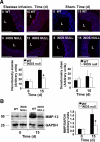Nitric oxide induces the progression of abdominal aortic aneurysms through the matrix metalloproteinase inducer EMMPRIN
- PMID: 19779140
- PMCID: PMC2751539
- DOI: 10.2353/ajpath.2009.080845
Nitric oxide induces the progression of abdominal aortic aneurysms through the matrix metalloproteinase inducer EMMPRIN
Abstract
Nitric Oxide (NO) is involved in the development and progression of abdominal aortic aneurysms (AAA). We found that inhibition of inducible NO synthase (iNOS) protects mice in an elastase-induced AAA model, significantly inhibiting the production of matrix metalloproteinase-13 (MMP-13). The extracellular MMP inducer (EMMPRIN; CD147) was increased in human AAA biopsies and in wild-type murine AAA but not in AAA from iNOS null mice. In cells overexpressing ectopic EMMPRIN, MMP-13 secretion was stimulated, whereas silencing of EMMPRIN by RNA interference led to significant inhibition of MMP-13 expression. In addition, elastase infusion of MMP-13 null mouse aortas induced a significant increase of EMMPRIN but reduced aortic dilatation when compared with wild-type mice, suggesting that NO-mediated AAA may be mediated through EMMPRIN induction of MMP-13. These findings were further verified in elastase-infused iNOS null mice, in which daily administration of NO caused a significant aortic dilatation and the expression of EMMPRIN and MMP-13. By contrast, in iNOS wild-type mice, pharmacological inhibition of iNOS by administration of 1400 W induced a reduction of aortic diameter and inhibition of MMP-13 and EMMPRIN expression when compared with control mice. Our results suggest that NO may regulate the development of AAA in part by inducing the expression of EMMPRIN and modulating the activity of MMP-13 in murine and human aneurysms.
Figures





References
-
- Baril DT, Jacobs TS, Marin ML. Surgery insight: advances in endovascular repair of abdominal aortic aneurysms. Nat Clin Pract Cardiovasc Med. 2007;4:206–213. - PubMed
-
- Ernst CB. Abdominal aortic aneurysm. N Engl J Med. 1993;328:1167–1172. - PubMed
-
- Mao D, Lee JK, VanVickle SJ, Thompson RW. Expression of collagenase-3 (MMP-13) in human abdominal aortic aneurysms and vascular smooth muscle cells in culture. Biochem Biophys Res Commun. 1999;261:904–910. - PubMed
Publication types
MeSH terms
Substances
LinkOut - more resources
Full Text Sources
Molecular Biology Databases

